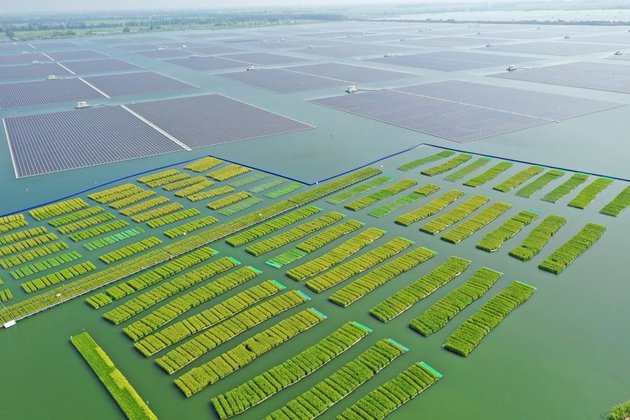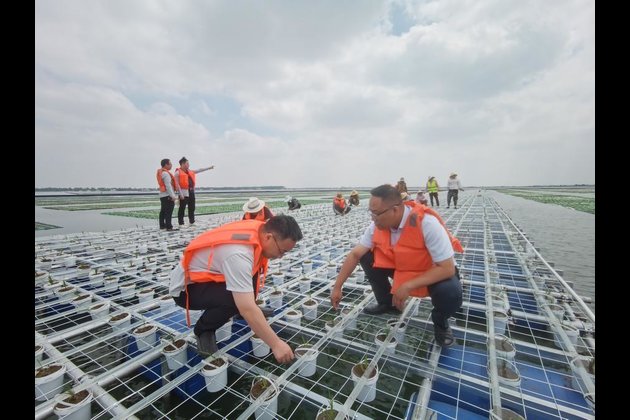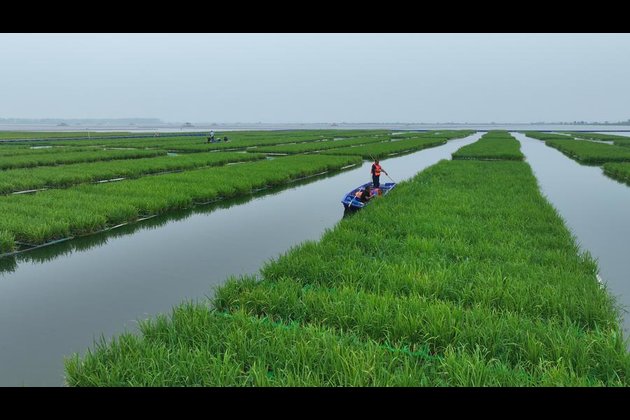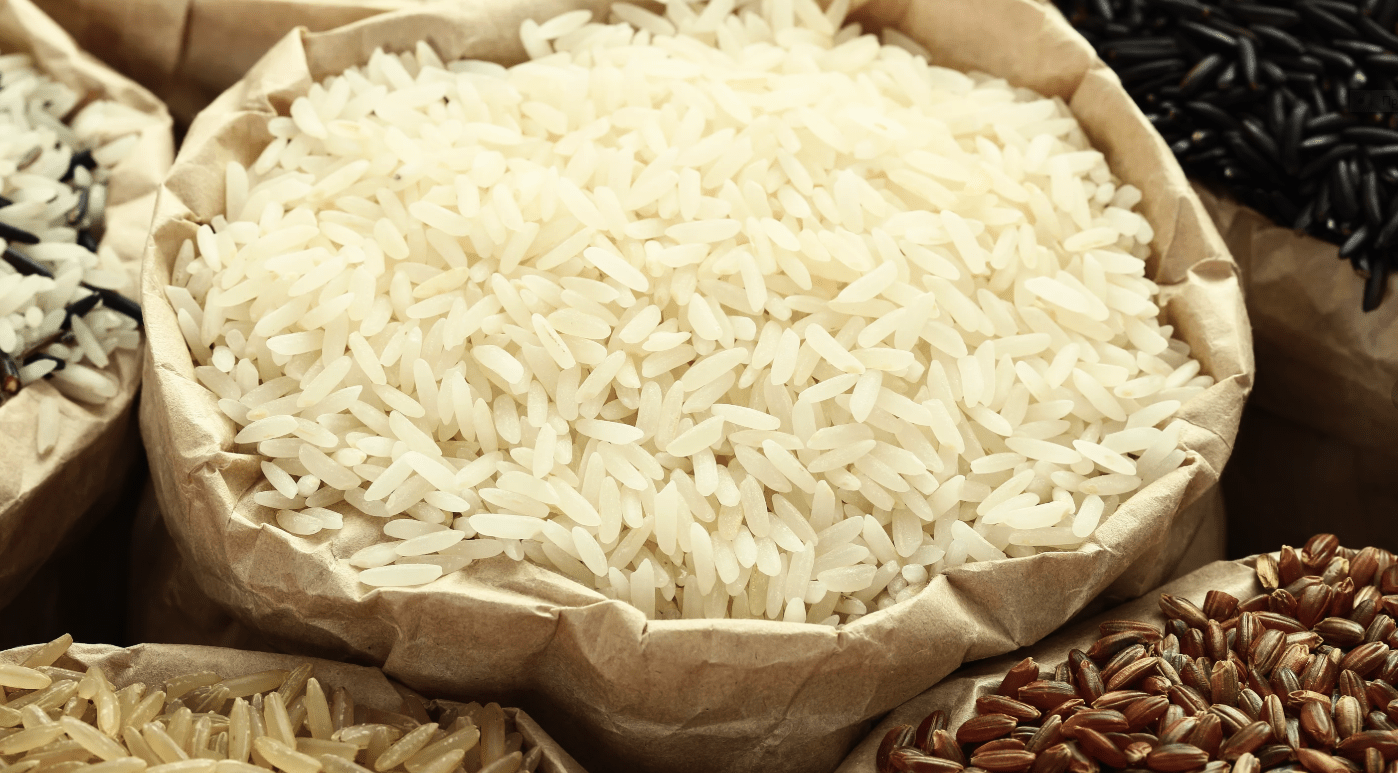Tags
China plants rice in coal-mining subsidence area
Xinhua

An aerial drone photo shows paddy fields in coal-mining subsidence area in Guqiao Town, Fengtai County of Huainan City, east China’s Anhui Province, Aug. 22, 2024. (Photo by Chen Bin/Xinhua)
HEFEI, Aug. 28 (Xinhua) — Squatting on the riverbank with his students, Cui Hongbiao carefully observes rice growing in a floating field in the water, with the sweat on his forehead glistening in the August sun.
As a teacher at the School of Earth and Environment at Anhui University of Science and Technology (AUST), Cui was pleased to see the once lifeless coal-mining subsidence area transformed into a thriving fishpond and rice paddy.
Not far away, the pale yellow of the rice ears, the green of the rice leaves, and the blue of the sky were reflected in the clear water, occasionally disturbed by fish leaping and splashing.
“We are exploring a rice-fish co-culture model in the shallow waters of coal-mining subsidence areas — growing rice on the water surface while conducting fish farming underwater,” said Cui.
This experimental field is part of a project titled the “Research and Demonstration of Key Technologies and Models for Water Surface Planting in Coal Mining Surface Subsidence Areas,” which is a collaboration between Huaihe Energy Holding Group Co., Ltd. and AUST. The project site is located in Guqiao Town, Fengtai County in the city of Huainan of east China’s Anhui Province.
In late August, with some parts of China gradually entering the harvest season, Cui and his team presented their results. The first batch of experimental rice varieties, planted early this year, have completed their initial harvest.
Following on-site inspections, report reviews and discussions, the evaluation panel, including several academicians from the Chinese Academy of Engineering (CAE), concluded that the harvested rice meets national quality standards based on authoritative testing.

Staff members check the growth of rice seedlings in Guqiao Town, Fengtai County of Huainan City, east China’s Anhui Province, June 6, 2024. (Photo by Xie Rui/Xinhua)
“Through this experiment, we have, for the first time, integrated a comprehensive set of rice planting and breeding technologies for water surfaces in coal-mining subsidence areas, offering an effective pathway for the comprehensive management of similar areas nationwide,” said Yuan Liang, an academician with the CAE and president of AUST.
Like in other countries, many regions in China are gradually depleting their resources due to years of coal mining, resulting in large areas of subsidence.
Research data and expert estimates from the National Development and Reform Commission indicate that coal-mining subsidence areas in China cover more than 20,000 square kilometers, growing by around 700 square kilometers each year. In the country’s central region, including Anhui, these subsidence areas make up about 70 percent of the national total.
“Surface subsidence is inevitable due to underground coal mining, surface farming, and the high overlap between urban and rural areas, creating challenges for managing these subsidence areas,” said Wang Shisen, chairman of Huaihe Energy Holding Group Co., Ltd.
“The success of this pilot project lies in creating non-traditional arable land, which helps to address the conflict between coal mining and farmland protection,” said Wang, who noted that their planting and aquaculture project in the shallow water areas of surface subsidence includes 50 mu (about 3.33 hectares) of trial water-surface rice cultivation.
“The evaluation results indicate that this project fills a gap in the green management of coal-mining subsidence areas in China,” said Xie Hongxu, vice president of the China National Coal Association.

Staff members do farm work in coal-mining subsidence area in Guqiao Town, Fengtai County of Huainan City, east China’s Anhui Province, July 30, 2024. (Photo by Xie Rui/Xinhua)
Experts from various institutions, including the Chinese Academy of Sciences and the Ministry of Agriculture and Rural Affairs, noted in the assessment that multi-parameter water-quality monitoring throughout the project indicated that water quality in the test area was better than before planting, and that rice planting improved the overall water quality.
Rice roots absorb large amounts of nutrients such as nitrogen, phosphorus and potassium from the water, which helps purify the water quality, which is beneficial in subsidence areas, according to the experts.
The project marks the first large-scale water-surface rice planting of its kind in subsidence areas in China. There is still a long way to go in innovation for the researchers, regardless of the current progress, said teacher Cui. “The rice-heading period is critical for pest and disease prevention, so we need to continue daily observations and maintain proper field management,” he said.
Wang with the Huaihe energy company is convinced of the benefit of the research as part of broader food-production efforts.
“No matter what, while we emphasize ‘seeking food from rivers, lakes, and seas,’ pursuing food production in coal-mining subsidence areas marks an important step in project research,” Wang said.
https://www.bignewsnetwork.com/news/274531956/china-plants-rice-in-coal-mining-subsidence-areaPublished Date: August 29, 2024







